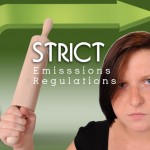Carbon credits explained!
The carbon credit trading technique is a crucial element of state and global emissions trading schemes to help manage global warming. But, what exactly are Carbon Credits? Now read on:

The idea behind using carbon credits is to cap industries at a global scale in the amount of yearly emissions they produce. In doing so, the hope is for organisations to consider and implement measures to scale back their greenhouse gas emissions.
Trading In Carbon Credits
Carbon credits may also be allotted a monetary worth, so making the chance for firms to trade the credits on a global market. Carbon credits correspond to a major trade-able quantity of greenhouse gas ( GHG ) emissions. They are routinely quoted in metric tons of carbon dioxide equivalent, and are used to offset emissions from the combustion of traditional fuels in any process that consumes energy that emits GHGs, whether in industry, transport or the household. Carbon credits are used in signatory states to the Kyoto Custom to meet emission reduction targets.
Countries all around the globe are using carbon credit cap and trade systems. In the States, a number of states are a part of the Western Climate Initiative, which started in California and now has extended to Arizona, Montana, New Mexico, Oregon, Utah and Washington. And in Canada, English Columbia, Manitoba, Ontario and Quebec have joined the Western Climate Initiative, according to CommonDreams.org. Carbon credits are a vital part of nationwide and world emissions trading schemes to help to control global warming.
Global Carbon Credits
The idea of using carbon credits is to cap industries at a global scale in the quantity of annual emissions they produce. In doing so, the hope is for organisations to consider and implement measures to reduce their greenhouse gas emissions. Carbon credits may also be allocated a financial value, therefore making the possibility for firms to trade the credits on a world market.
Carbon credits and carbon markets are a component of national and international attempts to mitigate the growth in concentrations of greenhouse gases (GHGs). One carbon credit is equal to one tonne of carbon dioxide, or in some markets, carbon dioxide equivalent gases. Carbon trading is an application of an emissions trading approach. Greenhouse gas emissions are capped and then markets are used to allocate the emissions among the group of regulated sources.
The goal is to allow market mechanisms to drive industrial and commercial processes in the direction of low emissions or less carbon intensive approaches than those used when there is no cost to emitting carbon dioxide and other GHGs into the atmosphere. Since GHG mitigation projects generate credits, this approach can be used to finance carbon reduction schemes between trading partners and around the world. via en.wikipedia.org
A Good Way to Think of Carbon Credits
In order to work out just what exactly carbon credits are, where they come from and how they work, we could use the analogy of our own credit cards which most of us still take for granted. Now, ask anyone who has fallen prey to not managing their finances properly about the consequences of this. Essentially, credit, when used responsibly, can achieve a great number of positive things in our lives, such as financing and paying off our dream hybrid or college tuition fees. But the danger is always there that this form of credit can be abused and when it is, the consequences can be quite dire, reversing the quality of life immeasurably. via www.conserve-energy-future.com
The backbone of the carbon credit system is a government or other regulating bodies that can attempt to limit the total tons of carbon dioxide emitted through the issuance and regulation of carbon credit. Carbon credit policies place a cost on carbon emissions by creating credits valued against one ton of hydrocarbon fuel. A carbon credit is fundamentally a permit that allows the receiver to burn a specified amount of hydrocarbon fuel over a specified period. The ceding of carbon credits are to companies or groups that act to reduce carbon emissions measurably. via www.investopedia.com
What Are Emissions Trading, or Cap-and-Trade Schemes?
A key feature of these markets is emissions trading, or cap-and-trade schemes, which allow companies to buy or sell “credits” that collectively bind all participating companies to an overall emissions limit. While markets operate for specific pollutants such as greenhouse gases and acid rain, by far the biggest emissions market is for carbon. In 2007, the trade market for C02 credits hit $60 billion worldwide — almost double the amount from 2006.
Emissions limits and trading rules vary country by country, so each emissions-trading market operates differently. For nations that have signed the Kyoto Protocol, which holds each country to its own C02 limit, greenhouse gas-emissions trading is mandatory. In the United States, which did not sign the environmental agreement, corporate participation is voluntary for emissions schemes such as the Chicago Climate Exchange. Yet a few general principles apply to each type of market. via www.cbsnews.com
Are Markets Really a Reliable Way to Drive Down Global Carbon Emissions?
Markets can be very effective for driving competition and reducing the cost of accomplishing an objective. However, what if that objective is the security of our climate and providing access to basic human rights such as food, water, education and good health? Paying for carbon credits at prices below what it costs to maintain a project means that these projects may stop operating in the vulnerable communities they support. Further, neglecting to fully account for the real value they deliver in beyond-carbon development benefits can accelerate a race to the bottom, meaning that the highest quality projects might be the first to fail. via www.goldstandard.org
Although carbon credits are beneficial to the society, it is not easy for an average investor to start using them as investment vehicles. The certified emissions reductions (CERs) are the only product that can be used as investments in carbon credits. However, CERs are sold by special carbon funds established by large financial institutions. The carbon funds set up the minimum investment amounts of millions of dollars, which provide small investors with the opportunity to enter the market.
There are special exchanges that specialize in the trading of the carbon credits, including European Climate Exchange, NASDAQ OMX Commodities Europe, and European Energy Exchange. via corporatefinanceinstitute.com
Carbon Credits of Different Types
What types of carbon credits are there? CER's ( authorized Emission Reductions ) are a type of carbon credit that is generated under Kyoto's Clean Development Mechanism ( CDM ). CER's are generated from a CDM project and come from developing nations. CER's can be sold to a developed country to help meet their Kyoto emission targets.
ERU's ( Emission Reduction Units ) are a kind of carbon credit that is generated under Kyoto's Joint Implementation ( JI ) mechanism.
The JI mechanism was made to allow emission sanctions to be traded from one industrialised country to another. ERU's infrequently come from a transnational investment from one company to another.
What are carbon credits / carbon offsets? When feeling a private obligation towards climate change, one should first try and rein in their carbon footprint thru reducing your own energy use. This could involve driving less, changing to more energy efficient vehicles or appliances, as well as many other stuff. Even with the maximum amount of conservation it is improbable that one can achieve having no carbon footprint, or emit no greenhouse gases in their method of life.
Further reading:[simpleazon-image align=”right” asin=”1844077276″ locale=”us” height=”110″ src=”http://ecx.images-amazon.com/images/I/51C7WW%2BXrvL._SL110_.jpg” width=”73″]
1. [simpleazon-link asin=”1844077276″ locale=”us”]Carbon Markets: An International Business Guide (Environmental Market Insights)[/simpleazon-link]
2. [simpleazon-link asin=”B0055LHITU” locale=”us”]Cap and Trade and Carbon Credits: An Introduction (5th Edition, April 2012)[/simpleazon-link][simpleazon-image align=”right” asin=”B0055LHITU” locale=”us” height=”110″ src=”http://ecx.images-amazon.com/images/I/51qtBIJYtNL._SL110_.jpg” width=”85″]
At roughly that point the very next thing to do is to offset the leftover greenhouse gas emissions and achieve carbon neutrality. The money one pays to offset one's remaining emissions goes to projects that need funding to stop the releasing of greenhouse gases ( like supportable energy developers and landfill gas capturers [landfill gas recovery]) or that remove greenhouse gases from the atmosphere ( like re-foresters ).
Greenhouse gases emitted anywhere in the world make a contribution to global warming and climate change. But, the opposite is also correct, removing or reducing greenhouse gases anywhere helps stop climate change.
We hope that this has explained the initial question which was: “What are Carbon Credits?”
UK Landfill Gas Emissions Control
The Stringent EA Controls, Which Limit UK Landfill Gas Emissions to Minimise the Emission of Carbon Dioxide thought to be a Significant Cause of Climate Change The UK waste management industry is required to control landfill gas emissions to a high standard. The Environment Agency (EA) is responsible for regulating landfills and ensuring that all […]
Landfill Site Permit Applications – The Role of Risk Assessments in Emissions Control
Landfill site emissions risk assessments are a mandatory requirement for environmental permit applications (previously known as Landfill Site PPC Applications). They identify possible hazards to the environment and public health from landfill gas and leachate. The procedure calls for a thorough examination of landfill emissions, including assessments of the effects on the air, groundwater, and surface […]
UK Landfill Gas Emissions – Stringent EA Controls Implemented
The waste management industry is required to control UK landfill gas emissions to a high standard. The Environment Agency (EA) ensures that all licensed (closed) or permitted landfill sites which contain landfill gas are regulated to ensure that emissions are kept to a minimum. This is enforced either under the pollution prevention and control (PPC) […]
How to Use Biogas from Landfills While Protecting the Environment
Read this to find out how to use biogas from landfills, and how using it also helps the environment and reduces the emission of greenhouse gases. Yes. Landfills for municipal solid waste, can be a source of renewable energy from their landfill gas. Landfill gas is “biogas”! Modern landfills are, in fact, just very large […]








Howdy! Carbon credits. The world needs better/ more than this. While this is being done, the problem is getting worse they say.